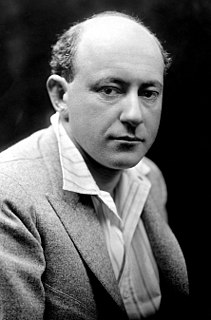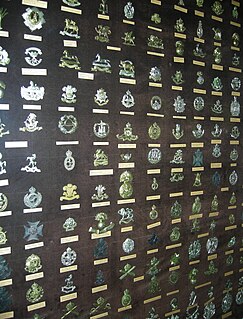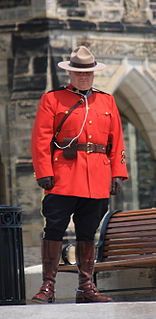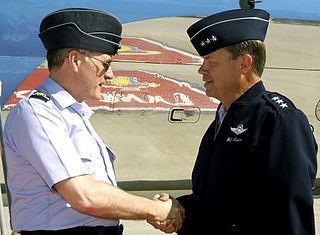
The Canadian military fur wedge cap, "envelope busby", or colloquially "The Astrakhan" [1] [2] is a uniform hat worn by the Canadian military and RCMP. The outside of the cap is entirely covered in real (e.g. seal skin or Persian lamb) or synthetic fur and is shaped like a wedge. When not being worn the cap folds flat. The cap is about 8 inches (200 mm) high but is normally worn with the apex of the wedge shape depressed back into the interior of the cap to form a longitudinal trough at the crown, reducing the overall height. Often the cap is patterned such that the front of the crown will be slightly higher than the back. On one side of the military style fur wedge cap hangs a flat flap made of cloth or wool that extends from the crown to the bottom of the cap, known as the "bag". The colour of the "bag" was determined by the regimental colours (e.g. the RCMP bag was yellow). The bag is very similar to that worn with the busby. Because of the cap's passing resemblance to the hussar busby author and researcher James J. Boulton [3] dubbed it the envelope busby. Still, whatever influence the busby may have had on its design, the fur wedge cap pattern was "distinctly Canadian." [3]
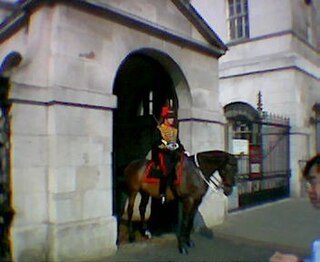
Busby is the English name for the Hungarian prémes csákó or kucsma, a military head-dress made of fur, originally worn by Hungarian hussars. In its original Hungarian form the busby was a cylindrical fur cap, having a bag of coloured cloth hanging from the top. The end of this bag was attached to the right shoulder as a defence against sabre cuts. In Great Britain busbies are of two kinds: (a) the hussar busby, cylindrical in shape, with a bag; this is worn by hussars and the Royal Horse Artillery; (b) the rifle busby, a folding cap of astrakhan formerly worn by rifle regiments, in shape somewhat resembling a Glengarry but taller. Both have straight plumes in the front of the headdress.

The Royal Canadian Mounted Police is the federal and national police force of Canada. The RCMP provides law enforcement at the federal level. It also provides provincial policing in eight of Canada's provinces and local policing on contract basis in the three territories and more than 150 municipalities, 600 aboriginal communities, and three international airports. The RCMP does not provide provincial or municipal policing in Ontario or Quebec.

Fur seals are any of nine species of pinnipeds belonging to the subfamily Arctocephalinae in the family Otariidae. They are much more closely related to sea lions than true seals, and share with them external ears (pinnae), relatively long and muscular foreflippers, and the ability to walk on all fours. They are marked by their dense underfur, which made them a long-time object of commercial hunting. Eight species belong to the genus Arctocephalus and are found primarily in the Southern Hemisphere, while a ninth species also sometimes called fur seal, the northern fur seal, belongs to a different genus and inhabits the North Pacific.
Contents
The fur wedge cap was used by both the North-West Mounted Police (NWMP), later Royal Canadian Mounted Police (RCMP), with the first examples coming into service in 1876 until 1901 and then again from 1928 until 1935. [3] Today the RCMP wear the Yukon pattern of fur cap that is similar to the Russian ushanka style. [3] [4] The other police unit that still regularly wears the fur wedge cap is the Toronto Police Mounted Unit as part of their full dress uniform. The Canadian military also wore the cap from about the end of the 19th century, and was formally adopted in the 1970s as the issued fur cap for all commands of the Canadian Forces during unification. [5] The bag was coloured rifle green. In Canadian Forces nomenclature it is known as Cap, Man’s Winter, Fur, C.F. Exactly when the fur cap stopped being in general issue is unclear; however, it is still being worn today by the officer cadets of the Royal Military College of Canada. [1] [6] [2] [7] As an example William Avery Bishop, Canadian flying ace, can be seen wearing the cap during his days in Royal Military College of Canada.

The North-West Mounted Police (NWMP) was a Canadian police force, established in 1873 by the Prime Minister, Sir John Macdonald, to maintain order in the North-West Territories. The mounted police combined military, police and judicial functions along similar lines to the Royal Irish Constabulary, and deployed the following year to the Alberta border in response to the Cypress Hills Massacre and subsequent fears of a United States military intervention. Their ill-planned and arduous journey of nearly 900 miles (1,400 km) became known as the March West and was portrayed by the force as an epic journey of endurance. Over the next few years, the police extended Canadian law across the region, establishing good working relationships with the First Nations. The force formed part of the military response to the North-West Rebellion in 1885, but faced criticism for their performance during the conflict.

An ushanka, also called a ushanka-hat, is a Russian fur cap with ear flaps that can be tied up to the crown of the cap, or fastened at the chin to protect the ears, jaw, and lower chin from the cold. An alternate manner is to bend the flaps back and tie them behind the head, which is called "ski-style" — this offers less protection from the elements, but much better visibility, essential for high-speed skiing. The dense fur also offers some protection against blunt impacts to the head.
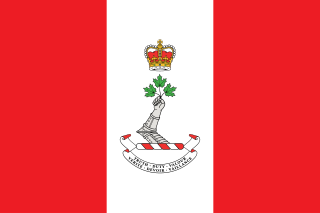
The Royal Military College of Canada, commonly abbreviated as RMC , is the military college of the Canadian Armed Forces, and is a degree-granting university training military officers. RMC was established in 1876 and is the only federal institution in Canada with degree-granting powers. The Royal Military College of Canada Degrees Act, 1959 empowers the college to confer degrees in arts, science, and engineering. Programs are offered at the undergraduate and graduate levels, both on campus as well as through the college's distance learning programme via the Division of Continuing Studies.
